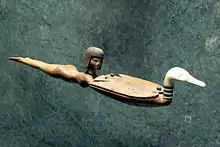| Cosmetic Spoon: Young Girl Swimming | |
|---|---|
 Cosmetic spoon featuring a swimming woman holding a duck, ivory and wood | |
| Material | Carob wood |
| Created | 1400 BC–1300 BC |
| Discovered | before 1852 |
| Present location | Louvre Museum, Paris, France |
Cosmetic Spoon: Young Girl Swimming is an ancient Egyptian carving by an unknown artist. Completed in the late Eighteenth Dynasty, sometime between 1400 BC–1300 BC, it currently resides in the Louvre, in Paris, France. It was acquired by the museum in 1852.[1] The spoon is made from partially painted carob wood, carved in a "sculpture in the round" fashion.
These spoons are also referred to as "toilet spoons". It is believed that cosmetic spoons were used to throw myrrh onto fires as offerings to gods or to the dead.[2]
References
- ↑ "Cuiller à fard à la nageuse". Louvre. 9 February 2023. Retrieved 20 December 2023.
- ↑ Brresc-Bautier, Genevieve (1991). Louvre: The Collections. Reunion des Musees Nationaux. ISBN 2-7118-2489-6.114.
Wikimedia Commons has media related to Cosmetics spoon E218.
This article is issued from Wikipedia. The text is licensed under Creative Commons - Attribution - Sharealike. Additional terms may apply for the media files.